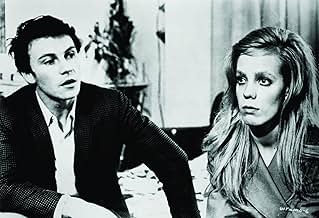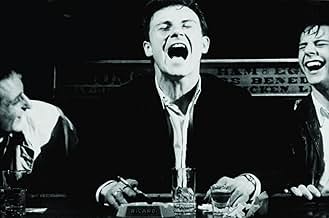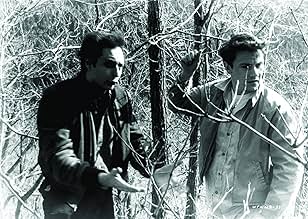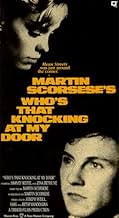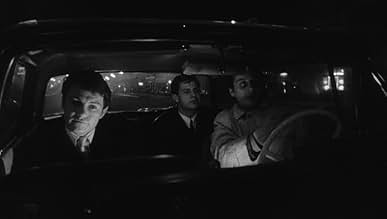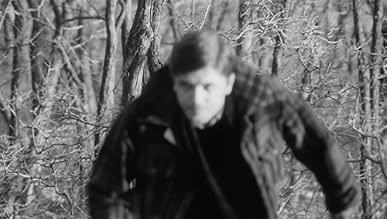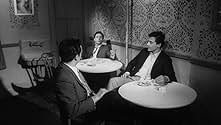PUNTUACIÓN EN IMDb
6,5/10
11 mil
TU PUNTUACIÓN
Un joven tiene dificultad con el hecho de que su pareja fue violada en el pasado.Un joven tiene dificultad con el hecho de que su pareja fue violada en el pasado.Un joven tiene dificultad con el hecho de que su pareja fue violada en el pasado.
- Dirección
- Guión
- Reparto principal
- Premios
- 1 nominación en total
Anne Collette
- Girl in Dream
- (as Ann Collette)
Philip Carlson
- Boy in Copake
- (as Phil Carlson)
Marrissa Joffre
- Girl at Party
- (as Marrisa Joffrey)
Victor Magnotta
- Boy in Fight
- (as Vic Magnotta)
Thomas Aiello
- Minor Role
- (sin acreditar)
Reseñas destacadas
I am an unabashed admirer of Martin Scorsese's work, and his first feature did not disappoint. Filmed on practically no budget, this movie uses a nonlinear approach to storytelling that predates "Pulp Fiction" by some 25 years. One can also see a precursor of Scorsese's later cinematic technique, and just a hint of his nightmare-world view of New York that is so apparent in his later works "Taxi Driver," "After Hours" and "Bringing Out the Dead." Scorsese's trademarkfinding the perfect piece of contemporary music for each sceneis also quite apparent here.
As the traditionally-minded J.R., the young Keitel turns in a riveting performance in his first film appearance, as a working-class New Yorker torn between his cultural norms and his love for an intelligent, independent woman. Bethune is today better known as a dancer and humanitarian, but as "The Girl" she is utterly convincing and nothing short of ravishing, with a presence both ethereal and self-assuredly erotic. The meeting of the two characters is really a meeting of the traditional with the modern--something much on people's minds in 1968 when this film was made. It's interesting that in some places this movie was retitled "I Call First"the gist of the conflict between the lovers. J.R. receives a piece of information about The Girl's past, one that he cannot put into perspective given his macho set of social norms. Scorsese throws in a dash of the Catholic morality and male-centeredness current at the time, and we have a memorable exploration of the place of culture and religion in determining who and how much we love.
If you're a Scorsese fan, this film is a must-rent. If you're uninitiated, see a couple of his later films first, then go back to this one for a look at two future giantsScorsese and Keitelon their first project, as well as an excellent performance by Bethune, who should certainly have had more featured roles following this one.
As the traditionally-minded J.R., the young Keitel turns in a riveting performance in his first film appearance, as a working-class New Yorker torn between his cultural norms and his love for an intelligent, independent woman. Bethune is today better known as a dancer and humanitarian, but as "The Girl" she is utterly convincing and nothing short of ravishing, with a presence both ethereal and self-assuredly erotic. The meeting of the two characters is really a meeting of the traditional with the modern--something much on people's minds in 1968 when this film was made. It's interesting that in some places this movie was retitled "I Call First"the gist of the conflict between the lovers. J.R. receives a piece of information about The Girl's past, one that he cannot put into perspective given his macho set of social norms. Scorsese throws in a dash of the Catholic morality and male-centeredness current at the time, and we have a memorable exploration of the place of culture and religion in determining who and how much we love.
If you're a Scorsese fan, this film is a must-rent. If you're uninitiated, see a couple of his later films first, then go back to this one for a look at two future giantsScorsese and Keitelon their first project, as well as an excellent performance by Bethune, who should certainly have had more featured roles following this one.
"Who's that knocking at my door" is along with "Boxcar Bertha" the most unknown picture of the Italian-American genius Scorsese. Make no mistakes: it's nothing like a masterpiece and it's no surprise that almost no one know about this movie, but here we got some of the constants in Marty's cinema: the street talking, the violence, the outsiders... Those things that "mean streets" dealt about... This was Martin Scorsese's debut and so it was for his friend Harvey Keytel who plays a chauvinist-bad tempered young man.
So, this is a movie that I recommend to those who really love Scorsese's work and wanna know about his origins.
*My rate: 6/10
So, this is a movie that I recommend to those who really love Scorsese's work and wanna know about his origins.
*My rate: 6/10
This is a hard movie to review because it's essentially an amalgam of several different shorter student films, and some work better than others.
That said, at the crux of "Who's That Knocking at My Door" (the final mass-released version) is a complex character-study laden with Catholic guilt and burdened by all the inherent stigmas and traditions of growing up Italian-American.
Obviously Scorsece knew his source material very well. More than half of the players and virtually all the locations come straight from his own life. What's really cool about the film, though, is how honestly he portrays these sociological nuances. He doesn't tell you Keitel's character's views and attitudes are good or bad, they just "are" --- and it's obvious how the character developed them from a peek into his everyday world.
This bracing honesty is the most appealing thing about the film, along with some drop-dead gorgeous camera work and editing featured here. The first scene where Keitel meets Bethune on the ferry has got to be one of the most imaginatively-shot and enthrallingly staged boy-meets-girl moments on celluloid. Throughout the film, Scorcese overlays soundless scenes from the past and future, creating interesting juxtapositions, always engaging and challenging your perceptions.
With a lot of debuts there are missteps. I don't think that fairly characterizes this movie however. There are definitely parts that drag and don't work well but seen in the context of a shorter film, they would have been more effective. As they're all blended together here, the pacing sometimes suffers.
It's hard to imagine any of the fans of Scorsece's later works, which rely so heavily on hyper-real camera-work and tightly-structured story lines, to have the patience for "Who's That Knocking." But for those who really enjoy the thoughtfulness, subversiveness, and subtext of Scorcese's films, it's a treat to see their origins so prominently displayed.
That said, at the crux of "Who's That Knocking at My Door" (the final mass-released version) is a complex character-study laden with Catholic guilt and burdened by all the inherent stigmas and traditions of growing up Italian-American.
Obviously Scorsece knew his source material very well. More than half of the players and virtually all the locations come straight from his own life. What's really cool about the film, though, is how honestly he portrays these sociological nuances. He doesn't tell you Keitel's character's views and attitudes are good or bad, they just "are" --- and it's obvious how the character developed them from a peek into his everyday world.
This bracing honesty is the most appealing thing about the film, along with some drop-dead gorgeous camera work and editing featured here. The first scene where Keitel meets Bethune on the ferry has got to be one of the most imaginatively-shot and enthrallingly staged boy-meets-girl moments on celluloid. Throughout the film, Scorcese overlays soundless scenes from the past and future, creating interesting juxtapositions, always engaging and challenging your perceptions.
With a lot of debuts there are missteps. I don't think that fairly characterizes this movie however. There are definitely parts that drag and don't work well but seen in the context of a shorter film, they would have been more effective. As they're all blended together here, the pacing sometimes suffers.
It's hard to imagine any of the fans of Scorsece's later works, which rely so heavily on hyper-real camera-work and tightly-structured story lines, to have the patience for "Who's That Knocking." But for those who really enjoy the thoughtfulness, subversiveness, and subtext of Scorcese's films, it's a treat to see their origins so prominently displayed.
WHO'S THAT KNOCKING AT MY DOOR? (3+ outta 5 stars)
Early feature film by the now-legendary Martin Scorsese... it sort of sprawls all over the place... melding all kinds of weird artsy gimmicks and camera styles... but the central relationship between Harvey Keitel and the pretty blonde girl he meets and falls in love with on the Staten Island Ferry (Zina Bethune) keeps the movie's momentum going, even when it veers off into interesting but sometimes pointless tangents. If you thought Quentin Tarantino invented the character of the movie geek who seeks to impress the woman of his dreams by rambling on with movie trivia... well, this movie will set you straight. You will also see hints of Scorsese's later masterpieces ("Mean Streets", "Goodfellas") in embryonic form. I hadn't seen this movie in years... but just saw the new DVD version and was amazed at how good it was.
Early feature film by the now-legendary Martin Scorsese... it sort of sprawls all over the place... melding all kinds of weird artsy gimmicks and camera styles... but the central relationship between Harvey Keitel and the pretty blonde girl he meets and falls in love with on the Staten Island Ferry (Zina Bethune) keeps the movie's momentum going, even when it veers off into interesting but sometimes pointless tangents. If you thought Quentin Tarantino invented the character of the movie geek who seeks to impress the woman of his dreams by rambling on with movie trivia... well, this movie will set you straight. You will also see hints of Scorsese's later masterpieces ("Mean Streets", "Goodfellas") in embryonic form. I hadn't seen this movie in years... but just saw the new DVD version and was amazed at how good it was.
a definite must for all scorsese fans. runs much like a student film. Use of music is still very ruff in this film. Not nearly as effective as in mean streets. Many of the same ideas scorsese will later work out in mean streets. Harvey Keitel's performance is powerful. Filmed mostly on Elizabeth St where scorsese grew up and his childhood apartment. highly recommended
What Scorsese Film Ranks Highest on IMDb?
What Scorsese Film Ranks Highest on IMDb?
Cinema legend Martin Scorsese has directed some of the most acclaimed films of all time. See how IMDb users rank all of his feature films as director.
¿Sabías que...?
- CuriosidadesIn order to get distribution for his film, Martin Scorsese was told to add nude scenes so it could be promoted as a "sexploitation" movie. He thus shot the fantasy scene showing J.R. imagining encounters with prostitutes.
- PifiasMartin Scorsese utilizes the black and white nature of film to hide the lack of time and day continuity in some scenes.
- Créditos adicionalesThere is a big "Thanks to the County and City of New York" in the end credits.
- Versiones alternativasEarly versions of this film were screened without the erotic fantasy scene.
- ConexionesFeatured in Una década bajo la influencia (2003)
- Banda sonoraJenny Take a Ride
(uncredited)
Written by Bob Crewe, Enotris Johnson, and Little Richard
Performed by Mitch Ryder & The Detroit Wheels
Selecciones populares
Inicia sesión para calificar y añadir a tu lista para recibir recomendaciones personalizadas
- How long is Who's That Knocking at My Door?Con tecnología de Alexa
Detalles
- Fecha de lanzamiento
- País de origen
- Sitios oficiales
- Idioma
- Títulos en diferentes países
- Qui truca a la meva porta?
- Localizaciones del rodaje
- Ámsterdam, Holanda Septentrional, Países Bajos(as New York, only interior, scenes with nudity)
- Empresas productoras
- Ver más compañías en los créditos en IMDbPro
Taquilla
- Presupuesto
- 75.000 US$ (estimación)
- Recaudación en todo el mundo
- 16.085 US$
- Duración1 hora 30 minutos
- Color
- Mezcla de sonido
- Relación de aspecto
- 1.85 : 1
Contribuir a esta página
Sugerir un cambio o añadir el contenido que falta

Principal laguna de datos
By what name was ¿Quién llama a mi puerta? (1967) officially released in India in Hindi?
Responde
